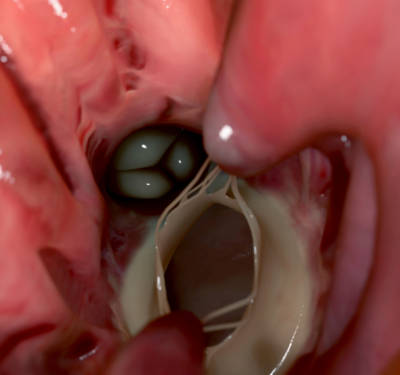Success of heart valve replacement
Researchers review the success of a heart operation for the replacement of a person’s diseased aortic valve after 15 years.
Published online 30 September 2016

Aortic valve replacement by a person's pulmonary valve is successful even 15 years after the surgery.
© The Science Picture Company / Alamy Stock Photo
The aortic heart valve (controlling the flow of blood from the heart to the rest of the body) sometimes needs to be replaced if it is not functioning properly. Often, this is done by removing the diseased valve and replacing it with a manufactured mechanical valve or a valve from an animal’s heart. The Ross procedure was developed in 1967 and involves replacing a diseased aortic valve with the patient’s own pulmonary valve (the valve controlling the flow of blood from the heart to the lungs for oxygenation). The removed pulmonary valve is then replaced with a pulmonary valve from a deceased organ donor.
A version of this procedure involves keeping the “root” of the aorta where it attaches to the heart in place (as opposed to removing it and replacing it with other supportive materials) and is called the inclusion cylinder method. Patients who undergo the Ross procedure do not need to take drugs that prevent the formation of blood clots, which can happen in the case of mechanical valves. These valves are also more durable than the alternatives, function well, and patients have higher exercise tolerance. The procedure has been restricted, however, to only a small number of centres that have the expertise to conduct it.
A team of researchers in Australia and the Netherlands reviewed the data of 204 patients who underwent the Ross procedure with the inclusion cylinder method for predominant narrowing of the aortic valve between October 1992 and February 2012. They found that 99% of these patients did not require re-operation on the aortic valve up to 15 years following the procedure; better than results of patients who undergo other types of valve replacement. The 15-year survival rate of the group was 98%. Among the 204 patients, only three had died and these were from cancer rather than heart-related issues.
The results show “that the use of this surgical technique in patients with predominant aortic stenosis [narrowing] provides a durable solution that is far superior to any other surgical technique and any other biological or mechanical valve substitute,” the researchers conclude in their study published in 2013 in the journal Global Cardiology Science & Practice.
A more recent study published in January 2016 in the International Journal of Cardiology followed the results of 42 patients who underwent the Ross procedure for aortic valve inflammation — or endocarditis — and found an overall survival at ten and 15 years was respectively 87 ± 5% and 81 ± 8%, with a low rate of recurrent endocarditis. They conclude the Ross procedure is an “interesting alternative” to mechanical valve replacement in these cases. Another 2015 study analysed data of 306 young adults who underwent the Ross procedure between 1991 and 2014 and found overall survival at 15 years since surgery was 88 ± 3%.
Reference
- Skillington, P. D. et al. Inclusion cylinder method for aortic valve replacement utilising the Ross operation in adults with predominant aortic stenosis – 99% freedom from re-operation on the aortic valve at 15 years. Glob. Cardiol. Sci. Pract. (2013) | article
DOI: 10.1038/qsh.2016.129

